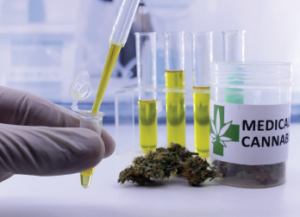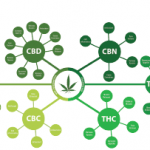
What do we know about cannabis treatment for chronic pain associated with rheumatologic conditions? Flapas / shutterstock.com
SAN DIEGO—What does cannabis offer to the treatment and management of rheumatology patients and the range of pain states they experience? What do we really know about its long-term effects? These are hard questions to answer with currently available data and a reality nuanced by complications cannabis advocates don’t always recognize, according to two experts presenting at the ACR/ARHP 2017 Annual Meeting Nov. 3–8.
Cannabis refers to all the various products and chemicals, including marijuana, derived from the cannabis plant. “We’ve had debates about cannabis, pro and con,” said Rosalie Pacula, PhD, of the Rand Drug Policy Research Center in Santa Monica, Calif. Debating the pros and cons of whether cannabis could be used therapeutically is no longer as relevant, she said, because marijuana has been legalized in states representing 20% of the U.S. population and is allowed for medical use in many others. The picture at the state level is further complicated by the fact that marijuana remains illegal under federal law. “We should now talk instead about what cannabis does and how it affects society,” she said.
States have been experimenting with cannabis policy since the 1970s, starting with decriminalization policies and then medical marijuana.1 But state policies on marijuana remain a hodge-podge that continues to evolve. Researchers must understand the impact of state policies on use. Too often, research findings neglect the heterogeneity of state policies, policy evolution and the timing of changes, Dr. Pacula said. Academic researchers have only just begun to see the implications of these nuances.
With legalization has come increased prevalence, product innovation, falling prices and a much higher chemical potency than in the past. Legalization can generate sizeable tax revenues and savings in criminal justice expenditures, she said, “but we don’t yet know other consequences or costs.” Could cannabis serve as a substitute for prescription opioid analgesics, affecting overdose mortality rates, as was suggested by Martin Bachhuber et al in JAMA Internal Medicine?2
“It’s possible. But we are a ways away from answering that question definitively.” With cigarette smoking, it took decades to determine true long-term effects, Dr. Pacula noted. “We haven’t done the studies of cannabis, particularly the high-potency cannabis available today, which could begin to answer many important questions. We don’t have any idea of long-term effects. It’s a scientific research agenda, not something [we’ll answer] definitively with one or two studies in the near future.”
Very little research has addressed concerns specific to rheumatologists.
What Do We Know?
Daniele Piomelli, PhD, professor of Anatomy & Neurobiology in the School of Medicine and director of the Institute for the Study of Cannabis at the University of California, Irvine, reviewed the evidence for cannabis as a potential therapeutic agent. Very little research has addressed concerns specific to rheumatologists, such as the chronic pain associated with rheumatologic conditions. One recent study concluded there is insufficient evidence to recommend any cannabinoid for symptom management in patients with chronic pain associated with rheumatic diseases.3
There are 104 known cannabinoids or active chemical compounds in marijuana. The best known is THC (tetrahydrocannabinol) and the second is CBD (cannabidiol). “The cannabis industry tells us CBD is really important, but that’s not yet based on data. And we can’t trust what we read on the Internet,” he said.
We do know cannabis can stimulate the appetite, reduce anxiety, change our pain threshold and impair short-term memory. “It’s not addictive in any comparable way to opioids,” Dr. Piomelli said. It delivers a subtle series of effects, which is no accident given that THC binds to abundant cannabinoid receptors in neurons and immune cells in the brain and throughout the body that serve multiple functions. The body also produces its own endocannabinoid neurotransmitters, which someday could provide signals for developing new therapies.
There’s a long list of purported therapeutic indications for which little evidence exists. “Those supported by the data are actually quite few,” Dr. Piomelli said, citing a January 2017 report by the National Academy of Sciences (NAS), The Health Effects of Cannabis and Cannabinoids.4 It found evidence supporting the treatment of:
- Chronic pain;
- Nausea/vomiting;
- Multiple sclerosis spasticity symptoms; and
- Short-term sleep outcomes.
But the NAS found limited or insufficient evidence for cannabis’ effectiveness with other conditions, such as glaucoma, cancer, epilepsy, irritable bowel syndrome, ALS, Parkinson’s disease or migraines. Potential risks include use during pregnancy and lactation, and effects on the brain when used during adolescence. “There’s a lot more work we need to do as researchers, and a gap between what society thinks vs. the actual data. My excuse as a scientist is that state and federal laws [limiting access to controlled substances for research] have made my job almost impossible,” he said.
One participant at the session asked what physicians and the rheumatology community can do to educate front-line providers. “Patients ask me about cannabis, and I’m clueless. There is such a wide gap in our knowledge.”
Dr. Piomelli said doctors and nurses need more education as part of a concerted effort to raise awareness. “I’m concerned about the staff in marijuana dispensaries,” he added. He said 90% give advice about marijuana’s therapeutic use, but only 10% have received any training about the actual therapeutics. “We can’t just say, ‘Oh, this is crazy,’ and do nothing.”
Larry Beresford is a freelance medical journalist in Oakland, Calif.
References
- Pacula RL, Smart R. Medical marijuana and marijuana legalization. Annu Rev Clin Psychol. 2017 May 8;13:397–419.
- Bachhuber MA, Saloner B, Cunningham CO, et al. Medical cannabis laws and opioid analgesic overdose mortality in the United States, 1999–2010. JAMA Intern Med. 2014 Oct;174(10):1668–1673.
- Fitzcharles MA, Baerward C, Ablin J, et al. Efficacy, tolerability and safety of cannabinoids in chronic pain associated with rheumatic diseases (fibromyalgia syndrome, back pain, osteoarthritis, rheumatoid arthritis): A systematic review of randomized controlled trials. Schmerz. 2016 Feb;30(1):47–61.
- National Academies of Sciences, Engineering, and Medicine. The health effects of cannabis and cannabinoids: Current state of evidence and recommendations for research. Washington, DC: National Academies Press (US); 2017 Jan 12.



